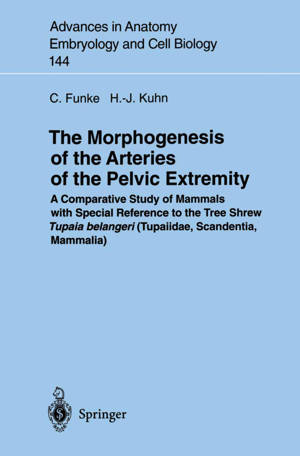
Je cadeautjes zeker op tijd in huis hebben voor de feestdagen? Kom langs in onze winkels en vind het perfecte geschenk!
- Afhalen na 1 uur in een winkel met voorraad
- Gratis thuislevering in België vanaf € 30
- Ruim aanbod met 7 miljoen producten
Je cadeautjes zeker op tijd in huis hebben voor de feestdagen? Kom langs in onze winkels en vind het perfecte geschenk!
- Afhalen na 1 uur in een winkel met voorraad
- Gratis thuislevering in België vanaf € 30
- Ruim aanbod met 7 miljoen producten
Zoeken
The Morphogenesis of the Arteries of the Pelvic Extremity
A Comparative Study of Mammals with Special Reference to the Tree Shrew Tupaia Belangeri (Tupaiidae, Scandentia, Mammalia)
Carolin Funke, Hans-Jörg Kuhn
€ 159,45
+ 318 punten
Omschrijving
Due to their pronounced intraspecific variability and to difficulties in defining their evolutionary trends in mammalian phylogenies, peripheral blood vessels have been neglected in comparative studies. Supported by the Sonderforschungsbereich 89 (Car diology) of the Deutsche Forschungsgemeinschaft, we have reconstructed the ontoge of the blood vessels of the tree shrew, Tupaia belangeri, on the netic morphogenesis basis of a series of developmental stages. The arteries of the lower extremity are described and discussed here. Besides describing the morphogenesis of the arteries in Tupaia, it is the aim of this study to explain the variability of the arteries of the pelvic extremity among mammals, and especially among primates including man, on the basis of a common developmen tal pattern. This can be shown in the following example. In the popliteal region of most adult mammals the arteria poplitea profunda is situated under the musculus popliteus. In the adult Tupaia, as well as in primates, this artery is missing but, superficial to the musculus popliteus, an arteria poplitea super ficialis exists. It seems difficult to explain such a case of "discontinuous evolution," because it is hard to imagine the position of the artery should have shifted through the muscle. The present investigation and the literature show that early in the embryonic development of a primate, man, and of Tupaia, both the arteria poplitea profunda and the arteria poplitea superficialis are present."
Specificaties
Betrokkenen
- Auteur(s):
- Uitgeverij:
Inhoud
- Aantal bladzijden:
- 97
- Taal:
- Engels
- Reeks:
- Reeksnummer:
- nr. 144
Eigenschappen
- Productcode (EAN):
- 9783540647065
- Verschijningsdatum:
- 23/09/1998
- Uitvoering:
- Paperback
- Formaat:
- Trade paperback (VS)
- Afmetingen:
- 156 mm x 234 mm
- Gewicht:
- 167 g

Alleen bij Standaard Boekhandel
+ 318 punten op je klantenkaart van Standaard Boekhandel
Beoordelingen
We publiceren alleen reviews die voldoen aan de voorwaarden voor reviews. Bekijk onze voorwaarden voor reviews.









